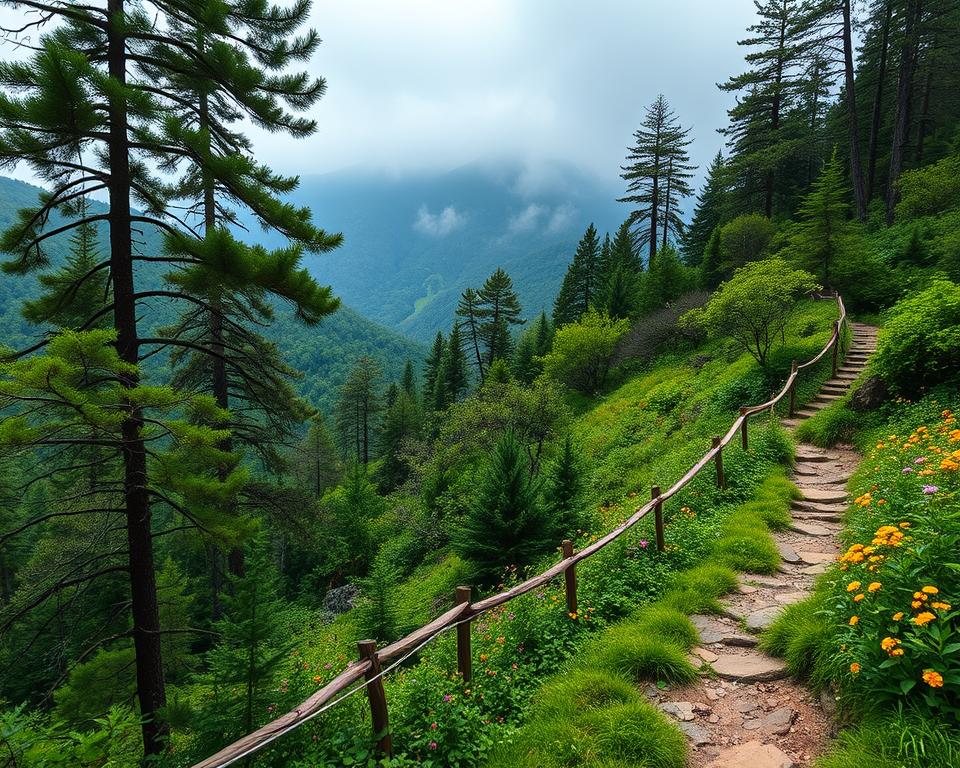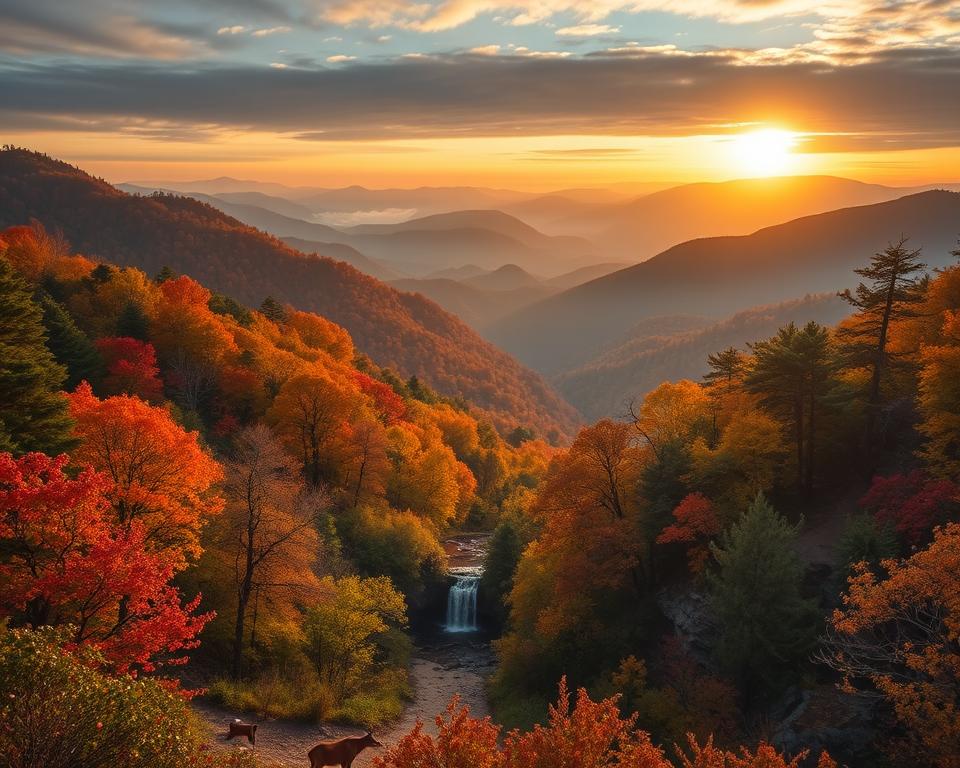Did you know Great Smoky Mountains National Park is the most visited national park in the U.S.? It welcomes over 12 million visitors every year. This natural wonder, in the Appalachian Mountains, offers an unmatched outdoor adventure.
You can explore amazing hiking trails, see diverse wildlife, and enjoy scenic drives and waterfalls.

This guide will show you the park’s different ecosystems, history, and stunning views. It’s packed with tips to help you plan the best Smokies trip. Whether you want a quiet escape, a family vacation, or an exciting outdoor adventure, the Great Smoky Mountains National Park has it all.
Overview of Great Smoky Mountains National Park
The Great Smoky Mountains National Park lies on the border of Tennessee and North Carolina. It’s the most visited national park in the U.S. This shows the amazing beauty and biodiversity of the Appalachian region.
The park covers over 521,490 acres. It’s home to black bears, white-tailed deer, and over 1,500 types of flowering plants. Its forests, hills, and streams are perfect for hiking, wildlife watching, and outdoor fun.
We suggest you read “A walk in the woods” by Bill Bryson. Bill is a very entertaining guide as he introduces you to the history and ecology of the trail.
The park has many hiking trails. These trails let visitors see the park’s different landscapes and find hidden spots. Trails like the Appalachian Trail and Alum Cave Trail are for all kinds of hikers. They offer a chance to enjoy the area’s natural beauty and history.

The park is also important for keeping the Appalachian way of life alive. It’s a UNESCO World Heritage Site. Visitors can see old forests, grist mills, and log cabins. This helps them understand the area’s rich history.
The Great Smoky Mountains National Park is great for anyone who loves nature, history, or just wants a quiet place. It has many ecosystems, trails, and cultural sites. It’s a true treasure of the American South.
Planning Your Visit to the Smokies
The Great Smoky Mountains National Park is a natural wonder in the Appalachian Mountains. It’s perfect for a weekend or a week-long adventure. Planning your visit is key for a great experience.
The best time to visit depends on what you like. Spring and fall have nice weather and fewer people. Summer is lively with green leaves and lots of activities. Winter is magical with snow and cozy cabins.
Getting into the park is free, but some activities cost money. Plan early to book campsites and explore trails.
There are many ways to get to the park, like driving, shuttles, or public transport. Inside, visitor centers and ranger stations offer helpful info and guides.
- Learn the park’s rules to have a safe visit.
- Book campsites and lodges early, especially in busy times.
- Try the park’s many hiking trails, from easy walks to tough hikes.
- Check out the park’s culture and nature at visitor centers and programs.

Planning your visit to the Great Smoky Mountains National Park lets you enjoy its beauty. With good planning and a sense of adventure, you’ll make unforgettable memories in this American gem.
Top Hiking Trails in the Park
Great Smoky Mountains National Park is famous for its many hiking trails. These trails are perfect for everyone, from those who love a gentle walk to those who enjoy a tough hike. The park has something for everyone, letting you see its natural beauty up close.
The Alum Cave Trail is a favorite among visitors. It’s a 5-mile round trip that takes you to the beautiful Alum Cave Bluffs. Along the way, you’ll see scenic views, cascading waterfalls, and unique rock formations. For a bigger challenge, try the Chimney Tops Trail. It leads to twin peaks with amazing panoramic views of the Smokies.
The Laurel Falls Trail is great for families and nature lovers. It’s a 2.6-mile easy hike to an 80-foot waterfall surrounded by vibrant wildflowers. Don’t miss the Clingman’s Dome Trail either. It takes you to the highest point in the Smokies, offering a 360-degree view of the majestic mountains and lush forests.
Whether you’re into easy walks or tough hikes, the Great Smoky Mountains National Park has it all. Its hiking trails let you explore the park’s stunning scenic landscapes and enjoy the peace of nature.
Scenic Drives Through the Mountains
Great Smoky Mountains National Park is famous for its stunning scenic drives. These drives let visitors enjoy the park’s beauty from their cars. The Cades Cove Loop Road, Newfound Gap Road, and Roaring Fork Motor Nature Trail are top choices. Each route offers a different view of the park’s landscapes and vistas.
The Cades Cove Loop Road is an 11-mile loop that shows the park’s history. Drivers can see old cabins, churches, and mills. They might also spot deer, bears, and turkeys. The fall colors make this drive even more beautiful.
Newfound Gap Road connects Gatlinburg, Tennessee, and Cherokee, North Carolina. It’s 31 miles long and offers amazing mountain views. Visitors can see the Rockefeller Memorial, the highest point on the Tennessee-North Carolina border. This drive is especially beautiful in winter with snow-covered peaks.
The Roaring Fork Motor Nature Trail is a 6-mile loop. It features historic buildings, streams, and wildlife. You can visit the Noah Bud Ogle Cabin or see the Roaring Fork creek and waterfalls. This trail is a must-see for its natural beauty.
These scenic drives in the Great Smoky Mountains are perfect for any visit. Whether you want a relaxing drive or an adventure, these routes have something for everyone. They offer unforgettable views and experiences for all ages.
Wildlife Viewing Opportunities
Great Smoky Mountains National Park is a top spot for wildlife lovers. It’s home to many species living in their natural habitats. You can see everything from black bears to elk roaming freely.
For black bear sightings, the Roaring Fork Motor Nature Trail is a great place. These amazing animals are often seen looking for food. But, remember to stay safe and keep a distance. Cades Cove is also known for its black bears.
- Observe elk grazing in the open fields of Cataloochee Valley, particularly in the early morning or late afternoon hours.
- Explore the park’s vast network of hiking trails to encounter a variety of bird species, from the vibrant and melodic songbirds to the elusive raptors soaring overhead.
- Visit the Oconaluftee Visitor Center and the surrounding areas to catch a glimpse of the park’s diverse bird population, including the iconic white-tailed deer.
To enjoy wildlife viewing responsibly, follow park rules. Keep a safe distance from animals and don’t feed them. With patience and a keen eye, you can see the park’s wildlife and make unforgettable memories.
Camping and Accommodation Options
Great Smoky Mountains National Park offers many camping and lodging choices. Whether you like backcountry camping or frontcountry sites, there’s something for everyone. The park has a wide range of options to consider.
For a true wilderness experience, try the park’s backcountry sites. These remote campsites are only accessible by hiking. They offer a chance to reconnect with nature and enjoy the forest’s sounds. Remember, reservations and permits are needed for backcountry camping.
On the other hand, frontcountry campgrounds offer a more accessible and amenity-rich experience. These sites are near roads and trails, with amenities like picnic tables and fire pits. Elkmont, Cades Cove, and Smokemont are some of the most popular spots, close to hiking trails and scenic drives.
The LeConte Lodge is a unique lodging option high atop Mount LeConte. It’s accessible by hiking or pack mule. The lodge offers cozy cabins and breathtaking views. Reservations are highly sought after, so book early.
Outside the park, you’ll find hotels, motels, and vacation rentals in nearby towns like Gatlinburg and Pigeon Forge. These places offer easy access to the park and various amenities for a more urban stay.
No matter your preference, the Great Smoky Mountains National Park has something for everyone. It ensures a memorable visit to this beautiful mountain landscape.
Must-See Waterfalls and Natural Attractions
Great Smoky Mountains National Park is famous for its stunning waterfalls. These waterfalls cascade over cliffs and through forests. Laurel Falls, an 80-foot beauty, is a favorite among visitors. It’s reached by a moderate hike.
Abrams Falls, with its 20-foot drop, is another highlight. It flows into a deep pool, attracting many hikers.
The park also has other natural wonders. Clingmans Dome, the highest point, offers views from its tower. You can see unique rock formations and geological features. Each has its own story.
Looking for a waterfall’s roar or the park’s serene beauty? Great Smoky Mountains National Park has it all. These attractions will surely impress you.
Seasonal Activities and Events
Great Smoky Mountains National Park is a year-round gem. It offers a wide range of activities and events for every season. From the colorful spring wildflowers to the breathtaking fall foliage, the park’s beauty is on full display all year.
In spring, the park’s wildflower shows are a sight to behold, with over 1,500 species in bloom. Trails like Alum Cave and Laurel Falls offer amazing views of the flowers. Summer is the best time for fishing, with many streams and rivers full of trout and bass.
- Fall brings a stunning fall foliage display, with the mountains painted in vibrant colors. Scenic drives on the Roaring Fork Motor Nature Trail and the Roaring Fork Motor Trail showcase the beauty of the changing leaves.
- Winter turns the park into a winter wonderland. It’s perfect for snowshoeing, cross-country skiing, and exploring historic cabins and mills.
The park also hosts many festivals and events all year. Highlights include the Spring Wildflower Pilgrimage, Smoky Mountain Harvest Festival, and Winter Magic Celebration.
Great Smoky Mountains National Park is a treasure all year. It offers endless opportunities to enjoy the outdoors and see the park’s ever-changing beauty.
Historical Sites and Cultural Heritage
Nestled in the Great Smoky Mountains National Park, visitors find a rich history and cultural heritage. Cades Cove is a key attraction, offering a peek into Appalachian history. It’s a beautiful valley that shows the area’s past.
Cades Cove has many historic buildings like log cabins, churches, and grist mills. These structures give insight into the lives of early settlers. The Mountain Farm Museum showcases traditional farming and craftsmanship of the Appalachian region.
The park also protects the area’s cultural heritage. Visitors can see artisans at work and enjoy festivals that celebrate Smoky Mountains music and food. These events highlight the region’s traditions.
Whether you’re into history or just want to see Appalachian culture, the Great Smoky Mountains National Park is a great place. It lets you connect with the past and today’s culture.
Visitor Centers and Ranger Programs
Great Smoky Mountains National Park has many visitor centers and ranger-led programs. These offer great learning chances for everyone. The centers are full of information about the park’s nature, culture, and fun activities.
The main visitor centers, like Sugarlands, Oconaluftee, and Cades Cove, have friendly park rangers. They help plan your visit. You’ll find interactive exhibits, displays, and lots of info on the park’s ecosystems, wildlife, and trails.
- Ranger-led programs, like guided hikes and talks, teach about the Smokies. They also show why conservation is key.
- The Junior Ranger program is great for kids. It teaches them to care for nature and appreciate it.
- The park also has special events, workshops, and festivals. These celebrate the area’s culture and history, letting visitors dive into the Smokies’ traditions.
Visiting the Smokies’ visitor centers and joining ranger programs can make your visit unforgettable. You’ll learn a lot and have a great time.
Weather Patterns and Seasonal Considerations
The Great Smoky Mountains National Park is in the Appalachian Mountains. It has different weather and climate all year. Knowing these changes helps visitors plan and enjoy their trips.
In spring, from March to May, it’s mild, with temperatures from the 50s to the 70s. Wildflowers are everywhere, and most roads and trails are open. But, there can be quick rain and snow at high places.
Summer, from June to August, is busy with warm, humid weather. It’s perfect for swimming, fishing, and seeing waterfalls. But, thunderstorms are common and might close trails or roads.
Autumn turns the Smokies into a colorful world, with leaves changing from late September to early November. It’s cool, from the 40s to the 60s, great for hiking and seeing sights. But, it can rain more and snow at high places.
Winter is cold and snowy, with temperatures below freezing. Some areas might be closed, but it’s quieter. Skiing, snowshoeing, and seeing animals are fun activities then.
Always check the weather before you go. Wear layers, good shoes, and bring rain gear. Knowing about road closures and weather dangers makes your visit better.
Conclusion
The Great Smoky Mountains National Park is a true gem. It offers a wide range of natural wonders and outdoor adventures. From waterfalls and ancient forests to scenic drives and wildlife, it’s a must-see for nature lovers and outdoor enthusiasts.
Looking for challenging hikes, wildlife spotting, or cultural heritage? The Great Smoky Mountains National Park has it all. Plan your trip today and experience the park’s stunning landscapes and stories.
The park’s rolling hills, misty peaks, streams, and wildflowers are breathtaking. Start planning your visit to explore this natural wonder. Discover the magic of this remarkable national treasure.



